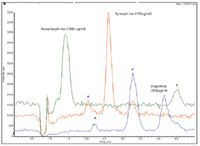Extraction of Sub-Nanogram Levels of Catecholamines from Human Plasma Using EVOLUTE? WCX
The Application Notebook
A new, efficient, effective, and sensitive sample preparation application for the extraction of the catecholamines epinephrine, norepinephrine, and dopamine from human plasma at significantly low levels using EVOLUTE WCX, a resin-based mixed-mode sorbent with an optimized combination of nonpolar (hydrophobic) and weak cation exchange interactions.
A new, efficient, effective, and sensitive sample preparation application for the extraction of the catecholamines epinephrine, norepinephrine, and dopamine from human plasma at significantly low levels using EVOLUTE WCX, a resin-based mixed-mode sorbent with an optimized combination of nonpolar (hydrophobic) and weak cation exchange interactions.
Catecholamines are standard biomarkers for the detection of diseases such as hypertention, pheochromocytoma, and neuroblastoma. Detection of these analytes in biological matrices (serum, plasma, and urine) at sub-nanogram per milliliter levels is critical in the clinical diagnosis of these and other diseases.
Extraction Conditions
This application note outlines the procedure using the EVOLUTE WCX 50 mg 3 mL column (part #612-0005-B) optimized for a 500 µL plasma sample volume, but other formats are available. Method parameters and dilution factors have been optimized to maximize recoveries and minimize ion suppression.
Sample pretreatment: Dilute 500 µL of plasma 1:1 (v/v) with 50 mM ammonium acetate, pH 7. Spike sample with internal standard.
Column conditioning: Condition column with methanol (1 mL)
Column equilibration: Rinse column with 50 mM ammonium acetate, pH 7 (1 mL).
Sample loading: Load pretreated plasma sample (1mL) at a flow rate of 1–2 mL/min.
Interference elution 1: Remove polar and ionic interferences with methanol:water (10:90) (2 mL).
Interference elution 2: Remove nonpolar and phospholipid interferences with isopropanol (2 mL).
Analyte elution: Elute catecholamines with methanol containing formic acid (95:5, v/v) (1 mL).
Post extraction: Evaporate to dryness and reconstitute sample in mobile phase (200 uL).

Figure 1: Extracted ion chromatogram for sub-nanogram levels of epinephrine (100 pg/mL), dopamine (200 pg/mL), and norepinephrine (1000 pg/mL) extracted from spiked plasma with EVOLUTE WCX. The peaks denoted by * are plasma artifact peaks observed at the LLOD.
The extracted samples were run on an Agilent 1200 Liquid Handling System with a Restek Ultra PFP Propyl 3-µm analytical column (50 × 2.1 mm id) at ambient temperature. The mobile phase was isocratic, 0.1% formic acid aq/methanol (98/2, v/v) at a flow rate of 0.200 mL/min for 5 min. The detector was an Applied Biosystems/MDS Sciex 4000 Q-Trap triple quadrupole mass spectrometer equipped with a Turbo Ionspray® interface for mass analysis. Negative ions were acquired in the multiple reaction monitoring mode (MRM); norepinephrine 170.2>152.2, epinephrine 184.1>166.1, and dopamine 154.3>137.3.
Results
Sample recoveries of over 85% with RSDs below 10% were achieved at pg/mL levels for epinephrine and dopamine and 1 ng/mL for norepinephrine. Figure 1 shows the extracted ion chromatogram.
Conclusions
This method demonstrates a robust and effective extraction of a range of catecholamines at significantly low levels from the challenging biological matrix of human plasma. Some artifact peaks from the plasma were observed in the extracted ion chromatogram but these had no effect on the ions of interest, resulting in a clean and interference free chromatogram
References
(1) Victor E. Vandell, Extraction of Sub-Nanogram Levels of Catecholamines from Human Plasma Using EVOLUTE® WCX. Application Note AN 739 (available from www.biotage.com).
Biotage, LLC
10430 Harris Oaks Blvd., Suite C, Charlotte, NC 28269
Website: www.biotage.com
Email: product_info@biotage.com

New Method Explored for the Detection of CECs in Crops Irrigated with Contaminated Water
April 30th 2025This new study presents a validated QuEChERS–LC-MS/MS method for detecting eight persistent, mobile, and toxic substances in escarole, tomatoes, and tomato leaves irrigated with contaminated water.
Accelerating Monoclonal Antibody Quality Control: The Role of LC–MS in Upstream Bioprocessing
This study highlights the promising potential of LC–MS as a powerful tool for mAb quality control within the context of upstream processing.
University of Tasmania Researchers Explore Haloacetic Acid Determiniation in Water with capLC–MS
April 29th 2025Haloacetic acid detection has become important when analyzing drinking and swimming pool water. University of Tasmania researchers have begun applying capillary liquid chromatography as a means of detecting these substances.

.png&w=3840&q=75)

.png&w=3840&q=75)



.png&w=3840&q=75)



.png&w=3840&q=75)



















